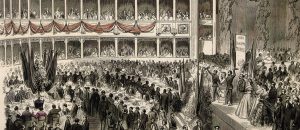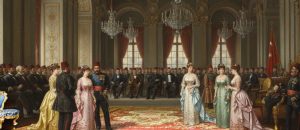The rich furniture collection of Dolmabahçe Palace is not only a display of luxury and wealth but also concrete evidence of how the understanding of power, comfort, and social life was radically redefined in the Ottoman Empire. The transition from Topkapı Palace’s traditional “ground-level layout” (yer düzeni) lifestyle—based on sedirs (low divans), cushions, and low tables (alçak sehpalar)—to Dolmabahçe’s European-style seating and living arrangement—based on high armchairs, tables, consoles, and beds (karyolalar)—symbolizes a profound cultural and political transformation, far beyond a simple change in taste. The Sultan now sitting in an armchair like a Western monarch, instead of cross-legged, was the most sincere and physical expression of modernization. [Link: Dolmabahçe Palace Collections -> /explore/palace-collections]
Life in Topkapı: The “Ground-Level Layout” (Yer Düzeni) and Communal Space
Life in Topkapı Palace was built upon a flexible and communal (toplulukçu) understanding of space, where the body remained close to the ground.
Seating Arrangement: The main seating elements were “sedirs” (divans), low couches lining the walls and covered with cushions and pillows. This arrangement required people to sit cross-legged or kneeling, encouraging a more intimate, collective form of seating.
Mobile and Multi-Purpose Furniture: The number of furniture pieces was few and generally portable. Low tables (sehpalar), lecterns (rahleler), and chests (sandıklar) were brought into and taken out of the space as needed. The same room could be a sitting room during the day and a bedroom at night, using mattresses spread on the floor (döşekler).
The Throne as a Symbol of Power: Even the throne, the most important symbol of power, was generally not very high off the ground, often taking the form of a kind of ornate sedir (divan).
This lifestyle carried the traces of the Ottoman nomadic past and its less formal, community-focused social structure.
The Revolution in Dolmabahçe: Elevated Bodies, Fixed Spaces
Dolmabahçe Palace completely abolished this ground-level layout, adopting a European-style model of life that elevated the body off the floor and fixed every space to a specific function.
Armchair, Sofa, and Chair: Sedirs were replaced by armchairs, sofas, and chairs, which emphasized individual seating. People were now sitting “up high,” not on the ground. This was not just a change in posture but also heralded a more individualistic and formal mode of social relationship.
Functional Spaces: Rooms were no longer multi-purpose. Every space, such as the dining room, bedroom, study room, and reception hall, had a fixed function and heavy, fixed furniture suitable for that function. In bedrooms, mattresses were no longer spread on the floor; people slept in carved wooden beds (karyolalar).
New Types of Furniture: Many new types of furniture, such as cabinets (dolaplar), display cases (vitrinler), chests of drawers (şifonyerler), consoles, and dressing tables (tuvalet masaları)—which were absent in Topkapı—entered palace life. This also indicated the development of the concept of personal belongings and private life.
Furniture Is a Language of Diplomacy
Dolmabahçe’s furniture preferences were designed to reflect particularly the styles of France (Louis XV, Louis XVI, Empire) and England (Victorian). This was not a random choice. When a [Link: European envoy or statesman -> /elciler-ve-imparatorlar-dolmabahce-sarayinda-bir-devlet-ziyareti-protokolu-nasil-islerdi] visiting the Palace saw this furniture, which was familiar from the palaces of their own country, they perceived the Ottoman Palace not as a “foreign” or “exotic” place, but as a “familiar” and “equal” setting.
The Sultan sitting in an armchair meant, in the language of diplomacy, “I am a European sovereign just like you”. A French-style “bergère” armchair or an English-style “chesterfield” sofa carried a message of modernity and equality more effective than a political note. In this respect, the palace furniture acted like silent diplomats.
Conclusion: The Transformation of Lifestyle
In conclusion, the furniture collection of Dolmabahçe Palace represents the most important documentation of a lifestyle revolution that redefined the concept of power and comfort in the Ottoman Empire. The transition from the sedir to the armchair, from the sini (low table) to the dining table, and from the mattress (döşek) to the bed (karyola) is not merely a change of object, but the story of a deep cultural transformation extending from body posture and social relations to the perception of space and diplomatic representation. The thrones, armchairs, and consoles of Dolmabahçe are the most elegant and concrete evidence of how an empire “Westernized” not only its governance but also its most fundamental way of living.
















